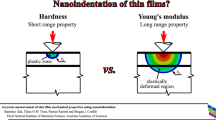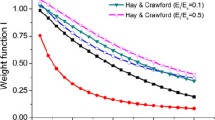Abstract
A novel method for the analysis of the mechanical properties of thin films is presented and uses a modified Winkler (bed of springs) approach to estimate indentation hardness and reduced modulus using nanoindentation data. This method is especially useful in situations where significant plastic deformation occurs in the thin film resulting in pileup of material and a divergence from accepted tip area calculations. The model has been adapted into a MATLAB® script and its derivation is presented. A proof of concept study was completed using Au thin films over a range of thickness and deposition methods. Results are compared with traditional nanoindentation analysis methods and validated against the Hall–Petch relationship. It can be seen that this modified Winkler approach accurately predicts material pile-up as well as contact area for films up to 500 nm in thickness.










Similar content being viewed by others
References
Y. Jung, B. Lawn, M. Martyniuk, H. Huang, and X. Hu: Evaluation of elastic modulus and hardness of thin films by nanoindentation. J. Mater. Res. 19 (10), 3076–3080 (2004).
D. Beegan, S. Chowdhury, and M. Laugier: The nanoindentation behaviour of hard and soft films on silicon substrates. Thin Solid Films 466 (1–2), 167–174 (2004).
W.C. Oliver and G.M. Pharr: An improved technique for determining hardness and elastic-modulus using load and displacement sensing indentation experiments. J. Mater. Res. 7 (6), 1564–1583 (1992).
R. Saha and W.D. Nix: Soft films on hard substrates — Nanoindentation of tungsten films on sapphire substrates. Mater. Sci. Eng., A 319–321, 898–901 (2001).
A. Bolshakov and G.M. Pharr: Influence of pileup on the measurement of mechanical properties by load and depth sensing indentation techniques. J. Mater. Res. 13 (4), 1049–1058 (1997).
A. Fischer-Cripps: Critical review of analysis and interpretation of nanoindentation test data. Surf. Coat. Technol. 200 (14–15), 4153–4165 (2005).
P. Põdra and S. Andersson: Wear simulation with the Winkler surface model. Wear 207 (1–2), 79–85 (1997).
D.S. Jang and D.E. Kim: Tribological behavior of ultra-thin soft metallic deposits on hard substrates. Wear 196(1–2), 171–193 (1996).
G. Bourne: A Methodology for Tribological Examination of Thin Films in the Nanodisplacement Regime. (ProQuest Dissertations and Theses, Florida, 2006).
E.A. Brandes and G.B. Brook eds.: Smithell’s Metals Reference Book, 7th ed. (Butterworth-Heinemann, Oxford, 1998).
J.E. Jakes, C.R. Frihart, J.F. Beecher, R.J. Moon, and D.S. Stone: Experimental method to account for structural compliance in nanoindentation measurements. J. Mater. Res. 23 (4), 1113–1127 (2008).
D.S. Stone, K.B. Yoder, and W.D. Sproul: Hardness and elastic modulus of tin based on continuous indentation technique and new correlation. J. Vac. Sci. Tech. A 9 (4), 2543–2547 (1991).
T. Spalvins and B. Buzek: Frictional and morphological characteristics of ion-plated soft metallic films. Thin Solid Films 84 (3), 267–272 (1981).
J.F. Nye: Physical Properties of Crystals (Claredon Press, Oxford, 1998).
M. Hebbache: Nanoindentation: Depth dependence of silicon hardness studied within contact theory. Phys. Rev. B 68 (12), 125310 (2003).
A. Kelly: Strong Solids (Oxford University Press, Oxford, 1966).
G.E. Dieter: Mechanical Metallurgy (McGraw-Hill, New York, 1986).
H. Conrad and K. Jung: Effect of grain size from mm to nm on the flow stress and plastic deformation kinetics of Au at low homologous temperatures. Mater. Sci. Eng., A 406 (1–2), 78 (2005).
ACKNOWLEDGMENT
The authors would like to acknowledge Dr. W. Greg Sawyer for his many helpful discussions and insights into nanoindentation mechanics.
Author information
Authors and Affiliations
Corresponding author
Rights and permissions
About this article
Cite this article
Boesl, B., Bourne, G.R. Analysis of thin films exhibiting large plastic deformation during nanoindentation: A modified Winkler approach. Journal of Materials Research 30, 2055–2063 (2015). https://doi.org/10.1557/jmr.2015.171
Received:
Accepted:
Published:
Issue Date:
DOI: https://doi.org/10.1557/jmr.2015.171




